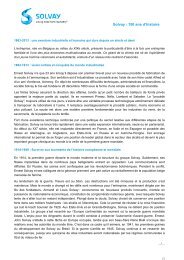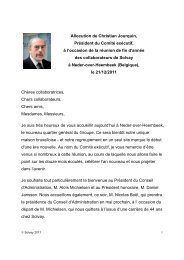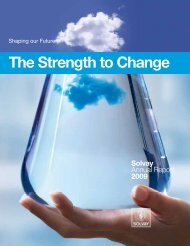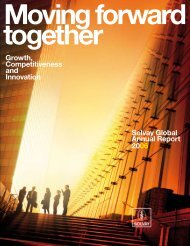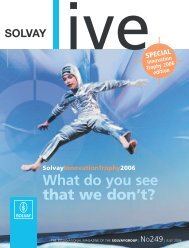THE FUTURE, - Solvay
THE FUTURE, - Solvay
THE FUTURE, - Solvay
Create successful ePaper yourself
Turn your PDF publications into a flip-book with our unique Google optimized e-Paper software.
206818 208967 209121<br />
S-300 EXPANSION IN GREEN RIVER<br />
The ultimate recovery<br />
of effl uent<br />
<strong>THE</strong> PROJECT. Effl uent from the trona (natural<br />
carbonate) processing plant at Green River (United<br />
States) is discharged into settling ponds.<br />
At the same time, the growing market for<br />
bicarbonate in the United States is for the S-300<br />
technical, low-cost grades, little demanding in<br />
terms of purity as they are used for fl ue gas<br />
cleaning in thermal electricity generating stations<br />
to neutralize SO 2 (sulfur dioxide). This fast-growing<br />
market is enormous.<br />
The idea therefore came up that such a product<br />
could be made by carbonating trona processing<br />
effl uent with CO 2, despite its high levels of salt,<br />
sodium sulfates and silica. After a technical study<br />
conducted at the CER Dombasle (France), the<br />
feasibility of the project was confi rmed.<br />
One unit is currently under construction and is<br />
scheduled to start in late 2009.<br />
Initially it will work with CO 2 purchased externally.<br />
Ultimately it is planned to use the CO 2 recovered<br />
on our sites.<br />
This original process has only advantages, in line<br />
with the Group’s imperatives for market growth,<br />
competitiveness, better use of our raw materials<br />
and limiting pollution. For instance, it may well<br />
obviate the need to build a new settling pond.<br />
Finally, it is also a fi ne example of intercontinental<br />
cooperation between the United States and<br />
Europe.<br />
SBU SODA ASH<br />
> Kurt Allen; Thoi-Dai Chau; Claude Criado;<br />
Perrine Davoine; David Hansen; Marc Mistiaen;<br />
Alain Vandendoren.<br />
BIO-ETHYLENE FOR VINYLS<br />
A “bio-PVC” from sugar<br />
and salt<br />
<strong>THE</strong> PROJECT. We wanted to increase our<br />
PVC offering in Brazil in response to the demand<br />
of a growing market. The problem was that we<br />
missed one of the main raw materials: ethylene.<br />
Ethylene production in this region of the world is<br />
in the hands of a single supplier.<br />
The innovative solution here was to manufacture<br />
bio-ethylene from bioethanol, coming from locally<br />
produced sugar cane, “bio” meaning that the raw<br />
material comes from a renewable natural<br />
resource.<br />
This idea is not that new, but we decided to build<br />
the very fi rst large scale plant, with a new reactor<br />
design and a low energy consumption process,<br />
adapting the quality of the ethylene to the use of a<br />
vinyl chloride (VCM) plant, capable of producing<br />
the fi rst “bio-PVC” from sugar and salt.<br />
SBU VINYLS<br />
> Joëlle Gaspard; René Castro; Paul Degraeve;<br />
Mauro Furlanetto; François Harvengt;<br />
Carlos Nardocci; Michel Strebelle; Sergio Zini.<br />
SOLVAY’S GREEN ROAD TO SUSTAINABLE<br />
TRANSPORT<br />
A black box for green roads<br />
<strong>THE</strong> PROJECT. <strong>Solvay</strong> has developed a pilot<br />
partnership in Europe with a group of carriers and<br />
start-up company G-Tech², to reduce the<br />
environmental impact, fuel consumption and risk<br />
connected with its road transport operations,<br />
which remain a important component of the<br />
Group’s logistics chain.<br />
Six subcontractor carriers have agreed to install in<br />
their vehicles the G-Box, a device designed by<br />
G-Tech², which observes driving, establishes<br />
benchmarks and helps drivers improve their<br />
behavior at the wheel. This creates a virtuous<br />
circle for the implementation of best practices,<br />
with the targets of lowering fuel consumption and<br />
greenhouse emissions by between 5% and 15%<br />
and reducing the risk of accidents during the<br />
transport of hazardous goods.<br />
Final validation of the system, following the pilot<br />
project, is expected by the end of 2009. A similar<br />
device, this time for company cars, is currently<br />
being tested at the <strong>Solvay</strong> head offi ce in Brussels.<br />
CC DIA-CPN<br />
> Erwin Tauber; Xavier Bacque; Jaime Ballbe;<br />
Jean-Francois Bastin; Alain Delzenne;<br />
Alain Fromont; Miguel Plaza; external partners:<br />
Juan Castellet; Eric Delsensries; Gaëtan Detroz;<br />
Michael Schaaf; Philippe Virtel.<br />
<strong>Solvay</strong> <strong>Solvay</strong> live live - JUILLET - JULY 2009 - 49




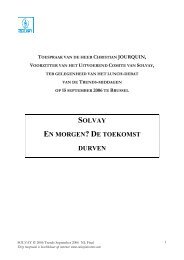
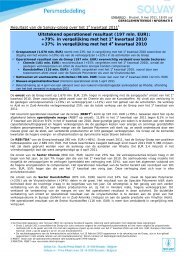

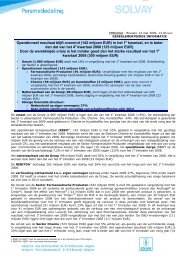
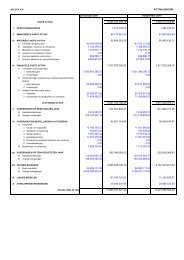

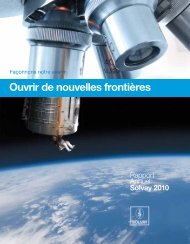
![PROC.1 [LETTRE] - Solvay](https://img.yumpu.com/16585746/1/184x260/proc1-lettre-solvay.jpg?quality=85)
